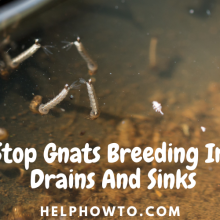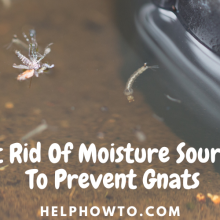How To Get Rid Of Gnats In Plants – Easy Guide | HelpHowTo
Summary of How To Get Rid of Gnats in Plants
Fungus gnats can be more than a nuisance, damaging indoor plants by feeding on roots and spreading disease. Understanding their life cycle is crucial for effective control. Signs include flying adults and larvae in soil. Cultural practices like using well-draining soil and allowing drying between waterings help prevent infestations.
Natural remedies like vinegar, hydrogen peroxide, cinnamon, and nematodes target different life stages. For severe cases, chemical insecticides containing pyriproxyfen disrupt the life cycle. Other options include sticky traps, repotting plants, or professional pest control. Potential downsides include harming beneficial organisms or unsuitable soil conditions. A multi-pronged, persistent approach combining cultural, natural, and chemical methods as needed is recommended.

Our Top 5 Recommended Indoor Genat Traps
Sick of pesky gnats invading your home? Discover the top 5 indoor gnat traps to banish these annoying insects for good! Our expert reviews reveal the most effective, easy-to-use traps. From powerful UV attractants to eco-friendly vinegar traps, we’ve thoroughly tested and ranked the best solutions. Check Now

Get Rid of Gnats in Plants – Complete Guide
Fungus gnats, those pesky little flies that seem to constantly buzz around houseplants, can be more than just an annoyance. These tiny insects can cause significant damage to your beloved indoor plants, making it crucial to take action and get rid of them promptly. In this comprehensive guide, we’ll explore the latest strategies and techniques for effectively eliminating fungus gnats from your plants, while also discussing potential downsides and considerations.
Understanding the Enemy: The Fungus Gnat Life Cycle
Before we delve into control methods, it’s essential to understand the life cycle of fungus gnats. Adult female gnats lay their eggs in moist soil, and within a few days, these eggs hatch into larvae or maggots. These larvae feed on organic matter, fungi, and plant roots for several weeks before pupating and emerging as adult gnats, ready to start the cycle anew. Grasping this life cycle is crucial for implementing targeted control measures.
Identifying the Infestation
The first step in addressing a fungus gnat problem is to identify the signs of an infestation. Adult gnats are easy to spot, as they are frequently seen flying around the plants or resting on the soil surface. However, detecting the presence of larvae in the soil is often the earliest indication of an infestation. Look for small, whitish-translucent worms or maggots wriggling in the top layer of soil. Additionally, using yellow sticky traps can help detect infestations before they become visually apparent.
Cultural Control and Prevention
Proper plant care and cultural practices can go a long way in preventing and managing fungus gnat infestations. Use well-draining, nutrient-rich soil mixes and allow the top few inches of soil to dry out between waterings, as gnats thrive in consistently moist environments. Quarantine new plants before introducing them to your indoor garden, and use sterile, packaged potting mixes to minimize the risk of introducing gnats. Regularly cleaning up plant debris and removing any decaying organic matter can also help discourage gnat populations.
Natural Remedies: Eco-Friendly Solutions
For those seeking eco-friendly alternatives, several natural remedies can be effective in controlling fungus gnats. Mixing a solution of vinegar or hydrogen peroxide and drenching the soil can kill larvae and disrupt their development. Sprinkling cinnamon or a layer of sand on the soil surface can deter egg-laying and create an inhospitable environment for gnats. Introducing beneficial nematodes or using mosquito dunks containing Bacillus thuringiensis israelensis (BTI) can also provide biological control by targeting the larvae.
Chemical Control Options
In cases of severe infestations, chemical control methods may be necessary. Yellow sticky traps can help monitor and reduce adult gnat populations, while insecticidal soaps and sprays can provide temporary relief. For more persistent infestations, systemic granule insecticides or sprays containing pyriproxyfen, an insect growth regulator, can disrupt the gnat life cycle and prevent future generations from developing. However, it’s important to exercise caution when using chemical treatments and follow all label instructions carefully.
Severe Infestations and Professional Assistance
If the gnat infestation is severe and persistent, despite your best efforts, it may be necessary to take more drastic measures. Repotting plants into fresh, sterile potting mix can help remove larvae and egg reservoirs, essentially resetting the infestation. In some cases, heavily damaged or infested plants may need to be discarded to prevent the spread of the problem. For widespread or stubborn infestations in the home, seeking professional pest control assistance may be advisable.
Potential Downsides and Considerations
While the methods mentioned above can be effective in controlling fungus gnats, it’s important to consider potential downsides and exercise caution. Some chemical treatments may harm beneficial soil organisms or pose risks to pets or children if not used properly. Additionally, using certain natural remedies like cinnamon or sand can alter soil conditions and may not be suitable for all plants. It’s always wise to research and follow product instructions carefully, ensuring compatibility with your specific plants and growing conditions.
Conclusion
Eliminating fungus gnats from your indoor plants requires a multi-pronged approach combining cultural practices, natural remedies, and, in severe cases, targeted chemical control measures. Consistency and vigilance are key, as these persistent pests can quickly reestablish themselves if conditions become favorable. By implementing the strategies outlined in this guide, you can effectively manage and prevent future gnat infestations, ensuring the health and vitality of your beloved houseplants.

Our Top 5 Recommended Indoor Genat Traps
Sick of pesky gnats invading your home? Discover the top 5 indoor gnat traps to banish these annoying insects for good! Our expert reviews reveal the most effective, easy-to-use traps. From powerful UV attractants to eco-friendly vinegar traps, we’ve thoroughly tested and ranked the best solutions. Check Now
FAQs and Answers
How long does it take to get rid of fungus gnats?
The time it takes to fully get rid of a fungus gnat infestation can vary, but most experts suggest allowing 4-8 weeks of consistent treatment and monitoring.
Several factors influence how long it takes:
Life Cycle – Fungus gnats have a rapid life cycle of around 3-4 weeks from egg to adult. So even if you kill off all the adults, there may still be eggs/larvae persisting.
Infestation Size – Larger populations with more egg reservoirs in the soil take longer to fully eliminate than smaller, contained infestations.
Treatment Methods – Using biological controls like BTI or nematodes may take longer (4-8 weeks) than chemical insecticides which can knock down populations faster (2-4 weeks).
Persistence – Being consistent with treatments, drying out soil, removing decaying matter, and monitoring with sticky traps is key. Stopping early allows resurgence.
Environment – Warm, humid conditions allow faster reproduction and complicated home infestations take longer to resolve.
The most important thing is to be patient and persistent. Continue treatments for at least a full 6-8 week cycle after first seeing gnats to break their life cycle completely. With diligence, most moderate infestations can be eliminated within 4-6 weeks.
Can fungus gnats harm humans or pets?
While fungus gnats themselves don’t bite or sting humans or pets, there are a few potential risks and nuisances they can cause:
Allergic Reactions
Some people can develop allergic reactions like eye irritation, nasal congestion or rashes when exposed to high numbers of fungus gnats. The gnats don’t inject anything, but proteins from their bodies can trigger allergies in sensitive individuals.
Contamination Concerns
Fungus gnats can potentially transfer pathogenic fungi or bacteria from the soil to surfaces around the home as they fly around. This could potentially contaminate food prep areas if populations get out of control.
Nuisance Pests
Large numbers of the tiny flying adult gnats can be extremely annoying and disruptive, especially in homes. They get in your face, land on you, and can make certain rooms unpleasant.
Risks to Pets
Pets that ingest a lot of fungus gnat larvae from infested plant soil could potentially get an intestinal infection or obstructions, though this is fairly uncommon. The larvae may also cause mild irritation if burrowed in pet skin.
Overall, fungus gnats are more of a nuisance for homeowners rather than a major health threat to humans or pets in most cases. However, reducing large infestations is still advisable for comfort and to mitigate any contamination risks, especially for those with allergies or sensitivities. Reasonable precautions are warranted.
What causes fungus gnat infestations in the first place?
Fungus gnat infestations are typically caused by the presence of excessively moist, organic soil conditions that the pests find attractive for laying their eggs. There are several common factors that can contribute to creating an ideal environment for fungus gnats:
Overwatering
One of the main culprits is overwatering houseplants. Fungus gnats thrive in constantly wet, soggy soil. Letting the soil stay saturated for too long allows fungus and decaying matter to accumulate – perfect for the larvae to feed on.
Poor Drainage
Using potting mixes that don’t drain well or pots without adequate drainage holes can lead to persistently damp conditions conducive to fungus gnat breeding.
Excessive Organic Matter
Soil or potting mixes very high in organic matter like peat moss, compost, or bark break down over time, creating food sources for the larvae.
Old Houseplant Soil
Not refreshing the potting soil in long-term houseplants allows the gradual buildup of fungi, algae, and debris that attracts the pests.
Decomposing Plant Matter
Letting dead leaves, stems, or other plant litter accumulate on the soil surface gives gnats a place to lay eggs and feeds the developing larvae.
High Humidity
While not a direct cause, fungus gnats thrive in warm, humid environments typical of many homes, greenhouses, and terraria setups.
Essentially, any consistently damp, organic-rich soil conditions with decomposing matter present can allow fungus gnat populations to explode if left unchecked. Adjusting watering practices and cleaning up decaying debris are key preventative steps.
Are there any home remedies or DIY traps for fungus gnats?
Yes, there are several effective home remedies and DIY traps that can help control fungus gnats using inexpensive household ingredients:
Home Remedies:
- Apple Cider Vinegar – Mix 1 part vinegar with 3 parts water and pour into spray bottle. Spray this solution onto the soil surface to kill larvae.
- Hydrogen Peroxide – A 3% solution of hydrogen peroxide can be used to drench the soil, killing fungus gnat larvae through oxidation.
- Cinnamon – Sprinkling cinnamon powder on top of the soil is thought to deter adult gnats from laying eggs due to the strong scent.
- Sand Topping – Covering the soil surface with a 1/4 to 1/2 inch layer of sand creates an unfavorable environment for the larvae.
- Neem Oil Spray – Mix a few teaspoons of neem oil with soap and water to make an insecticidal spray that can kill fungus gnat adults on contact.
DIY Traps:
- Bowl Trap – Place a small bowl filled with apple cider vinegar, wine, or beer near plants. The gnats are attracted to the liquid and get trapped.
- Sticky Trap – Coat a yellow card or plastic tray with petroleum jelly or sticky adhesive to catch adult gnats flying around.
- Potato Trap – Cut a potato in half and hollow out the middle. Place the potatopiece hollow-side down on the soil. Gnats are drawn inside and can’t escape.
- Banana Trap – Bury a small container with ripe/overripe banana pieces in the soil with the rim exposed. The gnats enter but have trouble exiting.
These homemade remedies and traps allow you to utilize common kitchen items to combat fungus gnats in a cost-effective, eco-friendly manner. Consistency is key when using them for best results.
How do you prevent fungus gnats from spreading between plants?
Preventing fungus gnats from spreading to other plants in your indoor garden requires diligence and care when handling infested plants. Here are some effective tips:
Quarantine Infested Plants
As soon as you notice a gnat infestation, immediately isolate those plants away from your other houseplants. Use a separate room, grow tent, or at minimum keep them several feet apart.
Avoid Reusing Soil
Never reuse potting soil from an infested plant on other plants. The eggs and larvae can persist and spread. Discard contaminated soil properly.
Use Barriers
Place infested plants on dishes or trays lined with sand or diatomaceous earth to prevent larvae from migrating to other pots or soil.
Clean Tools Thoroughly
Any tools, pots, or surfaces used with infested plants should be cleaned with a disinfectant solution to kill any eggs or larvae before using on other plants.
Isolate New Plants
When bringing new plants home, it’s wise to quarantine them separately for 4-6 weeks before introducing them to other houseplants just in case they harbored fungus gnats.
Inspect Regularly
Closely examine all plants, not just those with visible infestations, for signs of fungus gnat activity. Sticky traps can detect issues early.
Improve Airflow
Increasing airflow and keeping infested and uninfested plants separated can help prevent gnats from flying over and laying eggs elsewhere.
Use Systemic Controls
Applying systemic insecticides or beneficial nematodes to all plants can create a hostile environment that stops the spread.
By being proactive about quarantining, cleaning, and monitoring, you can prevent seemingly small fungus gnat issues from becoming larger, widespread problems across your entire indoor plant collection.

Our Top 5 Recommended Indoor Genat Traps
Sick of pesky gnats invading your home? Discover the top 5 indoor gnat traps to banish these annoying insects for good! Our expert reviews reveal the most effective, easy-to-use traps. From powerful UV attractants to eco-friendly vinegar traps, we’ve thoroughly tested and ranked the best solutions. Check Now




